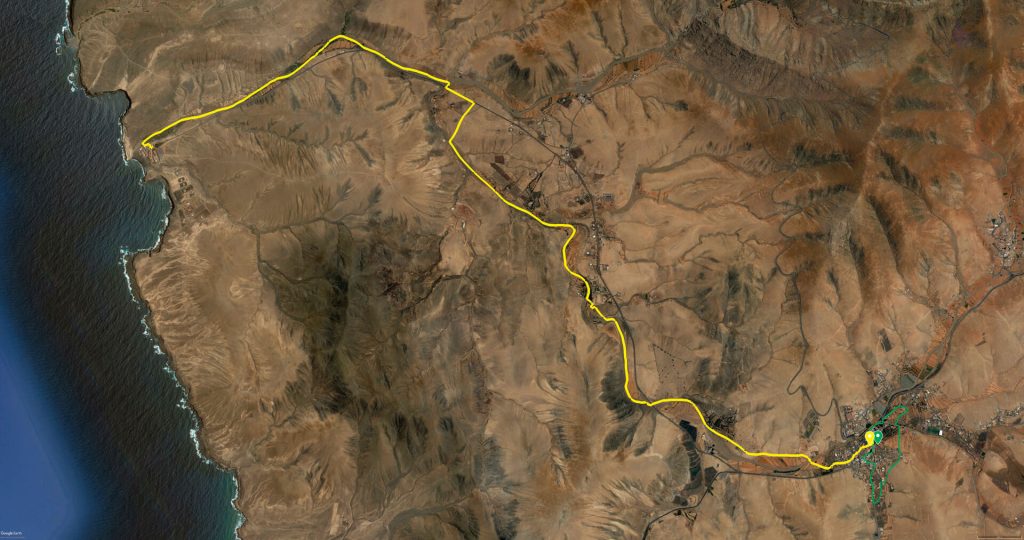
You are at the beginning of the yellow route between Pájara and Ajuy, and the green circular route to Tahona.
As you can see, both routes start in the Plaza de Nuestra Señora de Regla, where the church is located.
The church of Nuestra Señora de Regla is one of Pájara’s most emblematic monuments. Its construction began in the 17th century, presumably before 1687 due to a date engraved on the main doorway, although it was not completed until the 18th century.
For a time, the only parish that existed on the island was that of Santa María de Betancuria. The area gradually lost the importance it had had until then and places like Pájara became increasingly important, which led to the emergence of suffragan parishes in 1708.
Just a few years later, the church of Nuestra Señora de Regla was established as an auxiliary parish in 1711. This meant that although the church had only one nave, the creation of a new nave was ordered due to the increase in population. Its construction was completed in 1733 and it was blessed by the bishop in 1734.
Thus, the church has a total of two naves covered with hipped roof tiles, each of which has a sacristy attached to the front wall. The beauty of the façade and the craftsmanship of the stonemasons, with elements such as geometric figures, moons, birds, etc., are outstanding.
Lastly, it is worth mentioning the great importance of this church, which was declared an Asset of Cultural Interest in the category of Monuments in 1986.
The church of Nuestra Señora de Regla is still an important place of worship for the inhabitants of Pájara and the whole island of Fuerteventura. It is also one of the main tourist attractions in the area, owing to its architectural beauty and its historical and cultural importance.
If you want to start on the green route, leave by the Camino de la Guardería to continue along the Calle Lugar de Arriba to visit the Pozo del Amor and continue to the Calle Curva de Sindito to see the Pozo de la Curva.
Here you continue along the dirt road (Camino de Pájara) to reach the Corral de Consejo and leave at the Barranco de Tinarajo ravine and turn right onto the Camino Real until you reach Calle Las Criadas. Now turn right along Calle La Montañeta until you reach Calle de Los Geranios and turn left to reach La Tahona.
To get to the starting point, head towards Calle Las Veredas and Calle La Cañada.
For the yellow route, walk in the direction of the FV-30 and continue along Calle de Abajo until you reach Calle Manuel Sánchez Ramos and continue straight on along the dirt road, enjoying the picturesque settlement of Pájara.
Its history dates back to pre-Hispanic times in the Canary Islands. The Maho aborigines who inhabited the area were, as in Toto, involved in agriculture and livestock farming.
With the arrival of the conquistadors in the 15th century, various buildings began to be constructed throughout this period of dominion, including one of the most important in Pájara, the Church of Nuestra Señora de Regla.
During the 18th and 19th centuries, Pájara became an important centre of cereal production, due to the existence of fertile land in the area. The cochineal, an insect used for the production of natural dyes, was also cultivated. Cereal and cochineal production was exported to other islands in the archipelago and to the Iberian Peninsula.
The production of cereals and cochineal and its location meant that Pájara became a settlement for sailors arriving in the south of Fuerteventura, which in turn contributed to the development of the population, along with the livestock farmers.
The importance of Pájara resulted in the segregation of its parish in 1711, and a few years later, in 1834, Pájara achieved the definitive constitution of its town council.
In recent decades, Pájara has become an important tourist destination due to its historical and cultural heritage, as well as its beautiful beaches and natural landscapes, which you can discover by following the different routes we provide.
Continuing along the route, after continuing along the dirt road you will pass the Viejo Molino and cross the FV-621 to continue along the Barranco to the Tenería de Mezquez. Follow the Barranco until you cross the tunnel under the FV-621 and continue along the dirt road to La Madre del Agua.
Now, leave the Barranco de Ajuy ravine and turn right along the Camino de Pájara in the direction of the old house. At this point, follow the wall of Piedra Seca to the left to reach La Aduana, to continue along the wall discovering the old merchants’ buildings, reaching the pretty village of Ajuy.